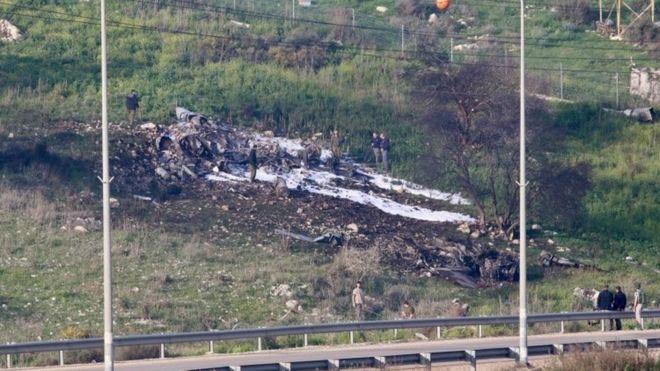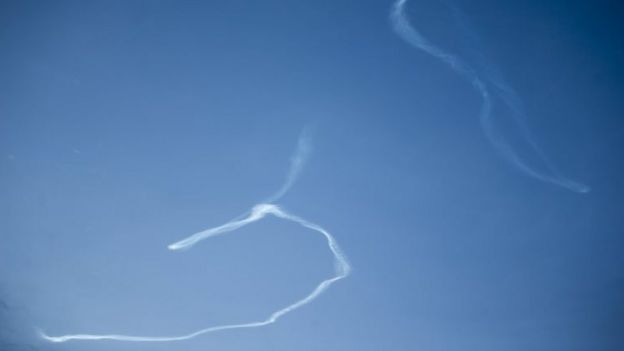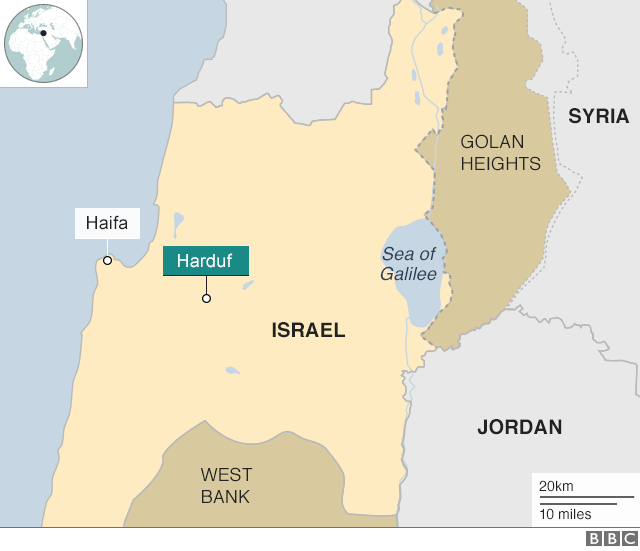 |
| The Israeli F-16 jet crashed near a village in northern Israel |
An Israeli F-16 fighter jet has crashed amid Syrian anti-aircraft fire after an offensive against Iranian targets in Syria, the Israeli military says.
The two pilots parachuted to safety before the crash in northern Israel. It is believed to be the first time Israel has lost a jet in the Syrian conflict.
Israel was carrying out strikes after the launch of an Iranian drone into Israel. The drone was intercepted.
Syria accused Israel of "aggression", as Israel then launched more strikes.
Israel Defense Forces (IDF) tweeted: "Moments ago, IAF aircraft, targeted the Syrian Aerial Defense System & Iranian targets in Syria. 12 targets, including 3 aerial defense batteries & 4 Iranian military targets, were attacked. Anti-aircraft missiles were fired towards Israel, triggering alarms in northern Israel."
Israeli strikes in Syria are not unusual, the BBC's Middle East correspondent Tom Bateman says, but the loss of an Israeli fighter jet marks a serious escalation.
How did events unfold on Saturday morning?
In a statement, the Israeli military said "a combat helicopter successfully intercepted an Iranian UAV [unmanned aerial vehicle] that was launched from Syria and infiltrated Israel".
It said the drone was identified quickly and was "under surveillance until the interception".
The drone went down on Israeli territory and was "in our possession", IDF spokesperson Brig Gen Ronen Manelis said.
The military said that in response the IDF "targeted Iranian targets in Syria". It said the mission deep inside Syrian territory was successfully completed.
After coming under Syrian anti-aircraft fire, the F-16's two crew ejected and were later taken to hospital. One of them was "severely injured as a result of an emergency evacuation", the IDF said.
It was not clear whether the F-16 jet was hit by anti-aircraft fire or went down near Harduf for other reasons.
It is the first time Israel has lost an aircraft in combat since 2006 when an Israeli helicopter was shot down over Lebanon by a Hezbollah rocket, the Jerusalem Post reports.
All five crew on board - including a female flight mechanic - were killed in that incident.
 |
| Anti-aircraft fire smoke over the Syrian-Israeli border in the Golan Heights |
Red alert sirens sounded in areas of northern Israel and the Israeli-occupied Golan Heights due to Syrian anti-aircraft fire.
Residents reported hearing a number of explosions and heavy aerial activity in the area near Israel's borders with Jordan and Syria.
 |
| The fighter jet was carrying out strikes on Iranian targets in Syria (file picture) |
Syrian state media quoted a military source as saying that the country's air defences opened fire in response to an Israeli act of "aggression" against a military base on Saturday, hitting "more than one plane".
What did Israel do next?
Later on Saturday, the army said a new wave of attacks was launched against 12 Syrian and Iranian targets in Syria.
Eight of the Syrian targets belonged to the fourth Syrian division near Damascus, IDF spokesman Jonathan Conricus said.
All the Israeli aircraft from this sortie returned safely.
"Syrians are playing with fire when they allow Iranians to attack Israel," the spokesman warned.
He added that Israel was willing to exact a heavy price in response but "we are not looking to escalate the situation".
Meanwhile, Iran, Russia and the Hezbollah movement in Lebanon - key allies of Syrian President Bashar al-Assad - dismissed as "lies" Israeli claims that an Iranian drone had entered Israeli airspace, news wires report.
In a joint statement, they vowed a "firm and tough response to any new aggression", the news agency reports.
What is the Iranian presence in Syria?
Iran is Israel's arch-enemy, and Iranian troops have been fighting rebel groups since 2011.
Tehran has sent military advisers, volunteer militias and, reportedly, hundreds of fighters from its Quds Force, the overseas arm of the Iranian Revolutionary Guards Corps (IRGC).
It is also believed to have supplied thousands of tonnes of weaponry and munitions to help President Assad's forces and the pro-Iranian Hezbollah, which is fighting on Syria's side.
Tehran has faced accusations that it is seeking to establish not just an arc of influence but a logistical land supply line from Iran through to Hezbollah in Lebanon.
What is the strategic context?
Analysis by BBC's diplomatic correspondent Jonathan Marcus
For years Israel has been striking at weapons stores and other facilities in Syria with a single goal - to disrupt and as far as possible to prevent advanced Iranian missiles being delivered to Hezbollah in Lebanon.
Syria has often been the conduit for these shipments. But the changing balance of power there, with the Assad regime's survival bolstered by Iranian help, has introduced a powerful new element - a direct Iranian role in the crisis.
A more confident Iran is alleged by Israel to be setting up bases in Syria(whether for its own or its proxy Shia militia forces is unclear).
But it is also alleged to be developing missile factories, both there and in Lebanon, to make the supply lines to Hezbollah less vulnerable.
Israel's campaign to disrupt missile supplies is becoming ever more complex.
And Iran risks becoming a direct actor in this conflict, ever closer to Israel's own borders.


No comments:
Post a Comment
Add a Comment...